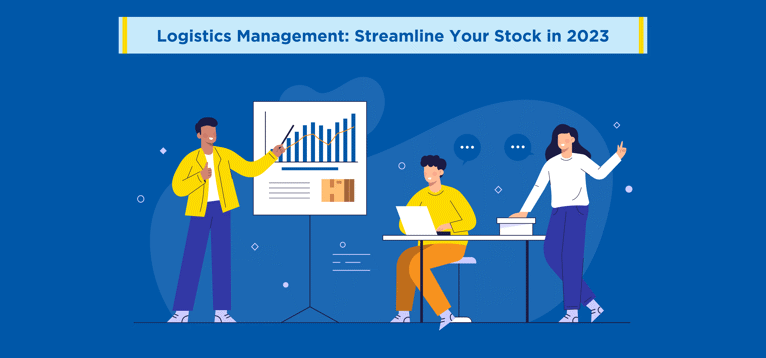Logistics have always played a central role in business strategies.
It is an answer to key questions that ultimately define the customer buying experience such as how, when, and where the customer will receive their order.
But, as a brand, before committing to the customer, you commit to the supply chain and logistics.
To put it simply, to grow your business, you need solid logistics management.
This guide talks about everything you need to know about effective logistics management and why it needs to be at the top of your strategic business goals.
What is Logistics Management?
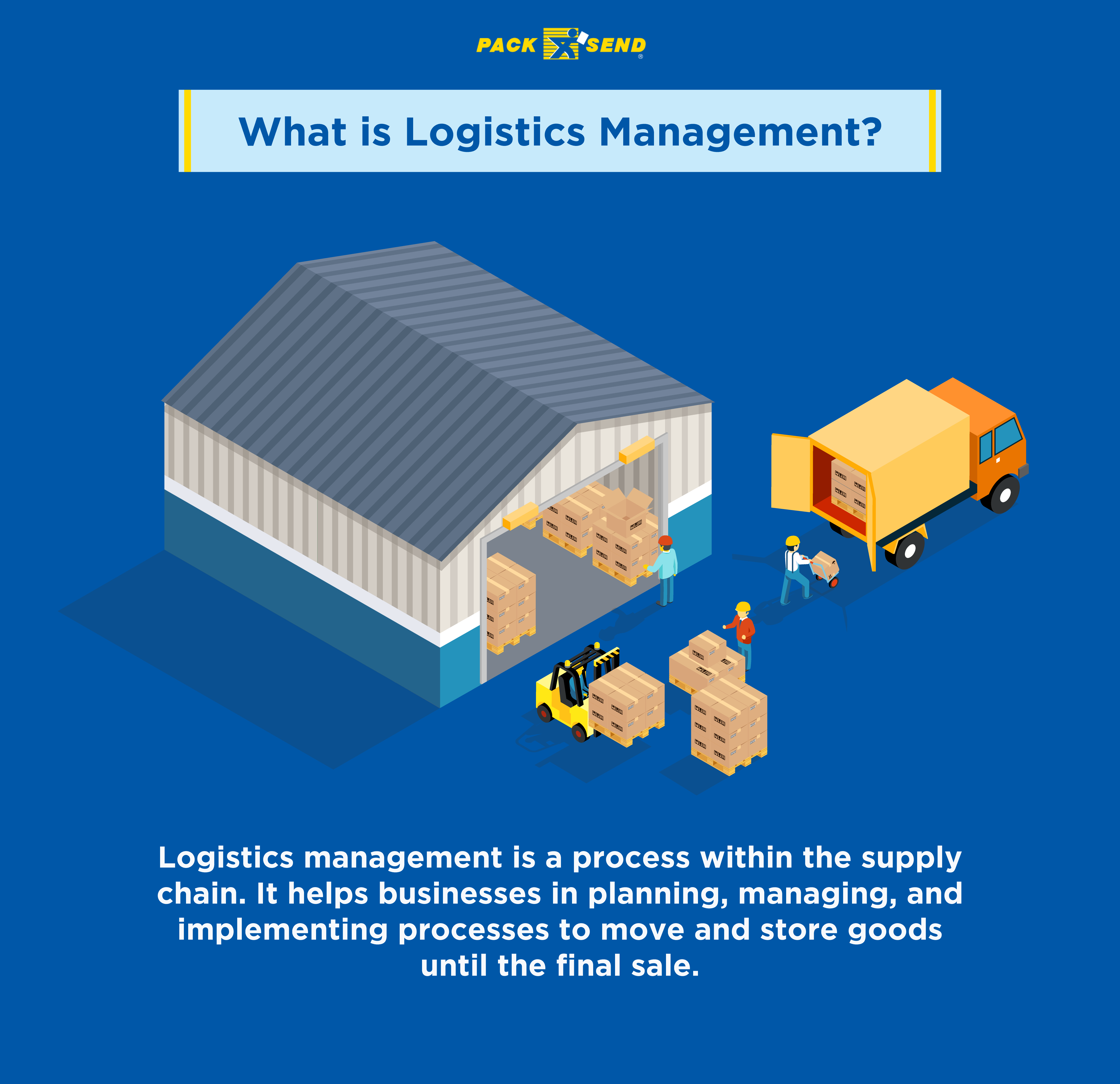
Logistics management is a process within the supply chain. It helps businesses in planning, managing, and implementing processes to move and store goods until the final sale.
Logistics management encompasses inbound, outbound, and reverse logistics in the eCommerce supply chain. It involves processes like:
- Ordering and receiving inventory
- Tracking inventory
- Warehouse and storage management
- Implementing technology
- Shipping and delivering orders on time
Logistics management is at the core of supply chain management. It involves managing critical logistics functions such as ensuring the seamless flow of information across the supply chain, material handling, inventory management, and warehouse management.
4 Major Types of Logistics Management
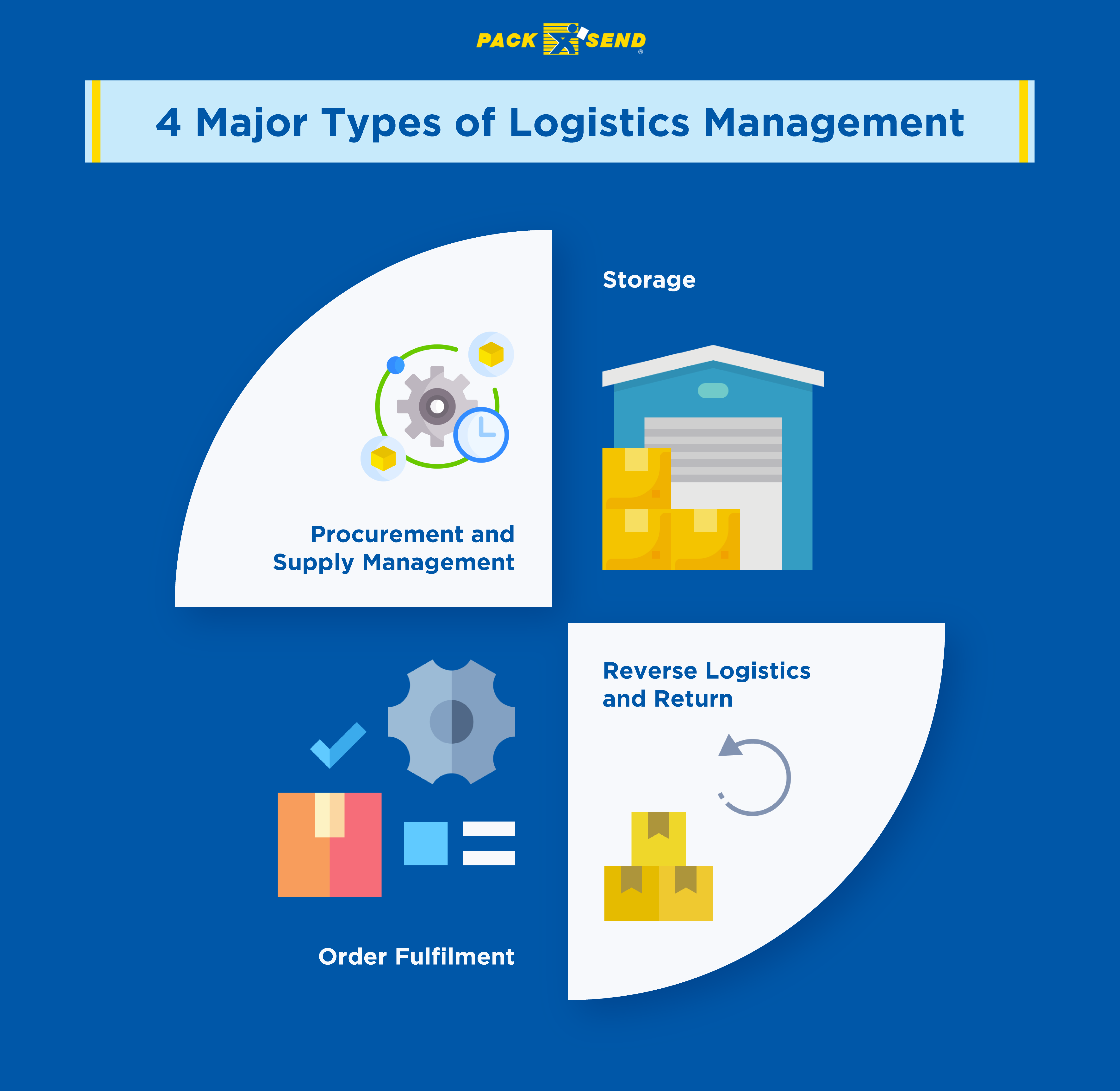
Logistics management is a long and complicated process. It is therefore divided into four main types to focus on different aspects of the supply chain process.
1. Procurement and Supply Management
Procurement logistics or sourcing is the first type of logistics management. There won’t be any inventory if you don’t source it first. It involves planning, ordering, and receiving raw materials or products that are needed by a specific deadline. Businesses check the quality, reliability, costs, and product lead times. They also take time to find the right suppliers and negotiate the terms and agreements.
Businesses further need to find the best form of transportation and storage. They assess the supply levels at different stages of the supply chain. It ensures that businesses meet the inventory levels and there are no hiccups in meeting customer demands.
2. Storage
After product sourcing comes storage. These include in-house fulfilment, rented warehouses, or 3PL fulfilment centres. You need to choose a method that’s the most cost effective and works best for the type of products you want to store. For example, if you’re storing perishable goods that are temperature sensitive, you’d have to store them in cold storage space.
Storage management prompts you to evaluate different expert freight service providers. If done right, storage can help you streamline your delivery. It helps speed up the packing process, all the while, saving on holding costs.
3. Order Fulfilment
Order fulfilment is the process of transporting stored goods to the consumer. It involves order processing, picking & packing workflows, and shipping of the finished product. It is this process that handles how your customer will receive your goods. So it should come as no surprise that this is one of the most critical elements of logistics management.
This part of logistics management controls the flow of goods from a single warehouse to either the end customer or the retail stores. That will depend on the business model. This is where businesses aim for cost-effectiveness, visibility, speed, and accuracy. Having the right order management infrastructure and technology helps businesses better manage logistics.
4. Reverse Logistics and Return
The choice of returning the product is one of the reasons why online shopping is at par with retail shopping. Return logistics has gained considerable popularity ever since the growth of online shopping.
And it’s not just the customer returns, but also returning the excess materials that need to be reclaimed after production. Reverse logistics schedule pickups to retrieve the extra supplies and product returns.
8 Steps of the Logistics Management Process
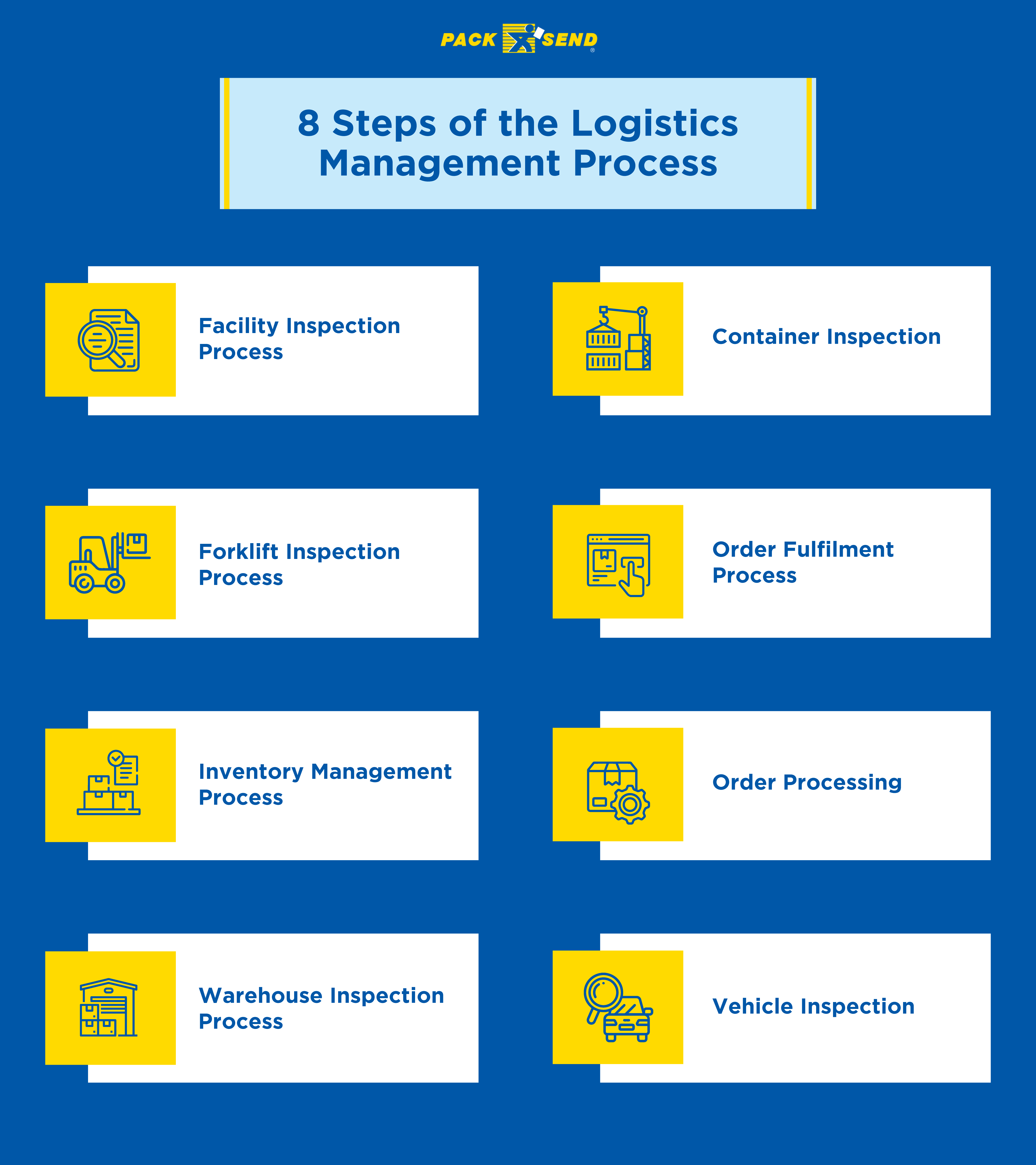
A lot of things go into ensuring safe and smooth logistics. Logistics managers usually adhere to the following process to eliminate potential hindrances.
1. Facility Inspection Process
It’s very necessary to create a safe working environment at a facility. The workers at a facility are prone to high risks. They live in an area where it’s common to encounter hazardous chemicals and large moving vehicles. Missing out on facility inspection poses risks that promote an unsafe working environment.
It’s essential to inspect the facility on a monthly basis. Managers need to take into account all the safety regulations. They need to ensure that measures are in place such as fire extinguishers, secured loading dock, proper lighting, etc.
Have a checklist that the manager has to go through in the inspection process. This way they can prevent everything that can get in the way of your employees’ work and prevent them from doing their tasks.
2. Forklift Inspection Process
If you’re in logistics, you would be familiar with a forklift. They are an essential part of warehouse machinery that is used to retrieve goods and load trucks. Without inspection, it is common for forklifts to break down and stall the loading and unloading process. Hence, it’s critical to check for oil leaks, motor functioning, guards, tires, etc.
A malfunctioned forklift also poses a serious risk to employees in the warehouse. If a forklift breaks down, you need to access the last inspection carried out to check if you could have avoided the problem. A forklift checklist can be of big help in this case. It provides you with a list of specific instructions to follow to assess the forklift. This way you can avoid any mishaps in the future.
3. Inventory Management Process
Having the right amount of inventory at the right time can assist you with optimising time and resources. This process deals with stocking and maintaining raw materials, finished goods, and WIP goods. Businesses can keep the demand in check, have adequate inventory at the time of demand, and avoid surplus due to the lack thereof.
To ensure you’re on the right track, have a checklist for managing inventory that includes points such as order lists, current stock levels, order approvals, tracking details, etc. You can entirely automate this via an inventory management system.
4. Warehouse Inspection Process
You cannot manage inventory if you don’t conduct a regular inspection. How else can you know where this inventory is stored in the first place? Inspecting your warehouse also helps you follow the rules and regulations for maintaining a safe workplace. Warehouse inspections include checking for damages, aisles, safety measures, obstructions, cleanliness, self-storage, etc.
5. Container Inspection
Logistics management doesn’t just involve managing goods that are stored. It also includes managing the goods that are in transit right up to the point they reach the end-consumer. Conducting an inspection for your ISO container ensures that your goods are secured while they’re being transported.
ISO container is a standardised freight container used to transport raw materials and goods. It can be transported via ship, rail, and trucks.
You need to check if the container is empty before new goods are loaded. Note the identification number, doors, and roof. Check to see if the interior and exterior are in the right condition.
6. Order Fulfilment Process
Order fulfilment, as we talked about before, is a crucial element in logistics. As soon as a customer places an order on the online store, the clock starts ticking. The logistics partner takes over the shipments to ensure the customer receives their products on time in the right condition.
While it may look like a simple process, order fulfilment can become challenging as you scale. You have to delegate responsibilities of packing and fulfilling orders. To improve order fulfilment, a fulfilment inspection keeps track of all the responsibilities. It keeps you informed of which product needs to be delivered and where. You need to check order details, receive payments, request items from inventory, record stock after fulfilment, etc.
7. Order Processing
Order processing is like fulfilment. But, order fulfilment goes into detail about the fulfilment process. It works better for large-scale eCommerce companies that have to automate most of their order manpicking-methods-to-streamline-your-product-deliveryagement.
If you don’t have too many orders and deliveries, you can opt for order processing as a part of your logistics management rather than fulfilment. It deals more with customer feedback, thereby giving you insights into customer satisfaction. It also requires fewer supervisors than order fulfilment.
8. Vehicle Inspection
You cannot take vehicle inspection lightly. Unlike other types of inspection, you don’t have to conduct a vehicle inspection on a regular basis. A yearly or a half-yearly inspection of cars, trucks, and vans, can help you find potential damage and faults.
If done right, businesses can save long-term repair costs. They can follow transport schedules and get a comprehensive view of asset depreciation and fleet condition.
Top 6 Methods to Streamline Your Stock
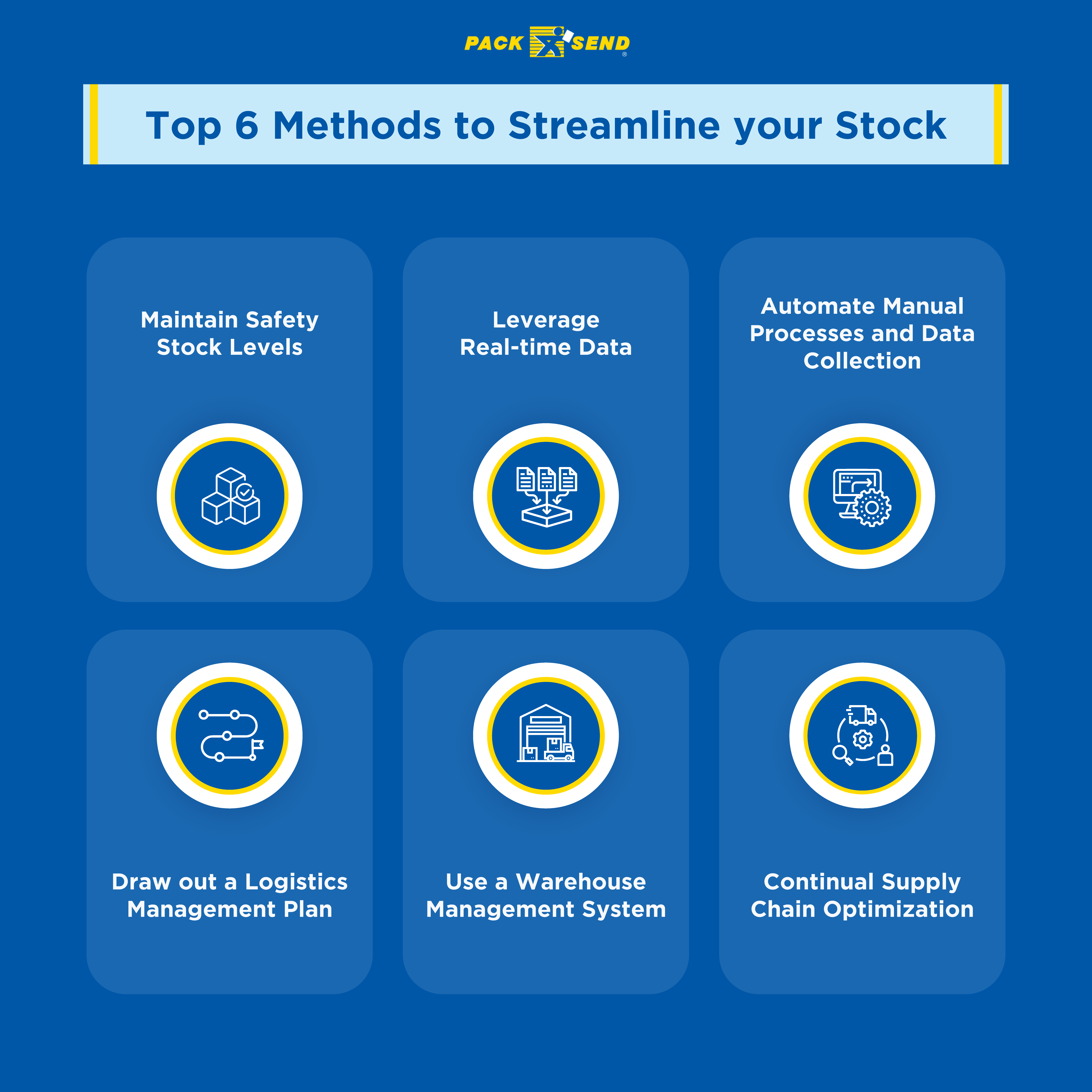
1. Maintain Safety Stock Levels
Inventory management is prone to uncertainties owing to the varying fluctuations of demand and supply. It would be ideal to have a safety net by maintaining a safety stock level. You can do this by using statistical formulas to get accurate demand forecasts.
Using this data, you can know how much stock to keep for each item and vendor. You can forecast demand using ERP systems to track inventory for each stock unit and each vendor.
2. Leverage Real-time Data
Logistics and stock management rely less on guesswork and are backed by real-time data. There are many systems that analyse your inventory and operations. Leverage that. Consolidating all your data under a single system also helps it easier to share, analyse, and communicate with key parties.
This data helps you compare performances, inventory levels, and purchasing costs to define the future course of action. It can help you speed up your order fulfilment and optimise routes.
3. Automate Manual Processes and Data Collection
Automation is essential in a highly volatile industry like logistics. To streamline delivery processes, leverage systems that optimise movement across the supply chain. These systems include inventory management, order management, and other ERP systems.
You can also integrate tracking systems that help you inspect the delivery processes. Keep an eye out for newer technological evolutions to expand your efficiencies.
4. Draw out a Logistics Management Plan
Logistics management is a compilation of many activities. Draw out a logistics management plan first. It helps you to avoid getting caught up in inventory turmoil. It means listing down your goals, KPIs, available resources, and the systems and tools required to achieve these goals. Brainstorm with your management and figure out how you will get the suppliers on board. And how you'll choose a 3PL provider, access high-quality materials and meet delivery timelines.
When you have everything noted down, it becomes easier to streamline your stock. For example, if the supplier says the standard delivery time is seven days, you can schedule your deliveries. You can buy enough stock to last those many days at once. You can then better optimise your inventory and make iterations to improve speed and accuracy.
5. Use a Warehouse Management System
A warehouse management system elevates your inventory management efforts. It decreases inventory levels and improves order fulfilment. WMS helps you access real-time data in a coherent format. You can streamline logistics and enhance visibility throughout many warehouses. It ultimately promotes consistency in your supply chain.
A platform for warehouses ensures that all your customers get the same kind of services in logistics from you. With integration with the ERP inventory system, you can add relevant data. You can include details of inventory forecasting, SKU velocity, inventory days on hand, etc.
This way your warehouses are on the same page. They all know how much inventory they should store, how they should package materials, what is the standard delivery time, etc.
6. Continual Supply Chain Optimization
While managing the logistics, it should always be your goal to operate the supply chain at peak efficiency. Supply chain optimization is a continuous process since your KPIs will change as your competitiveness increases. You need to work towards delivering products to customers at the lowest cost, all the while maintaining a high level of profit.
Logistics managers have to balance the costs of manufacturing, transportation, customer service expectations, and inventories. They also have to consider the fluctuations in material costs, carrier changes, route changes, customer demographics, etc. Taking these factors into account, you can eliminate extra costs associated with extra warehouses, expensive suppliers, long routes, and long delivery times.
Top 8 Reasons for Having Logistics Management in Supply Chain
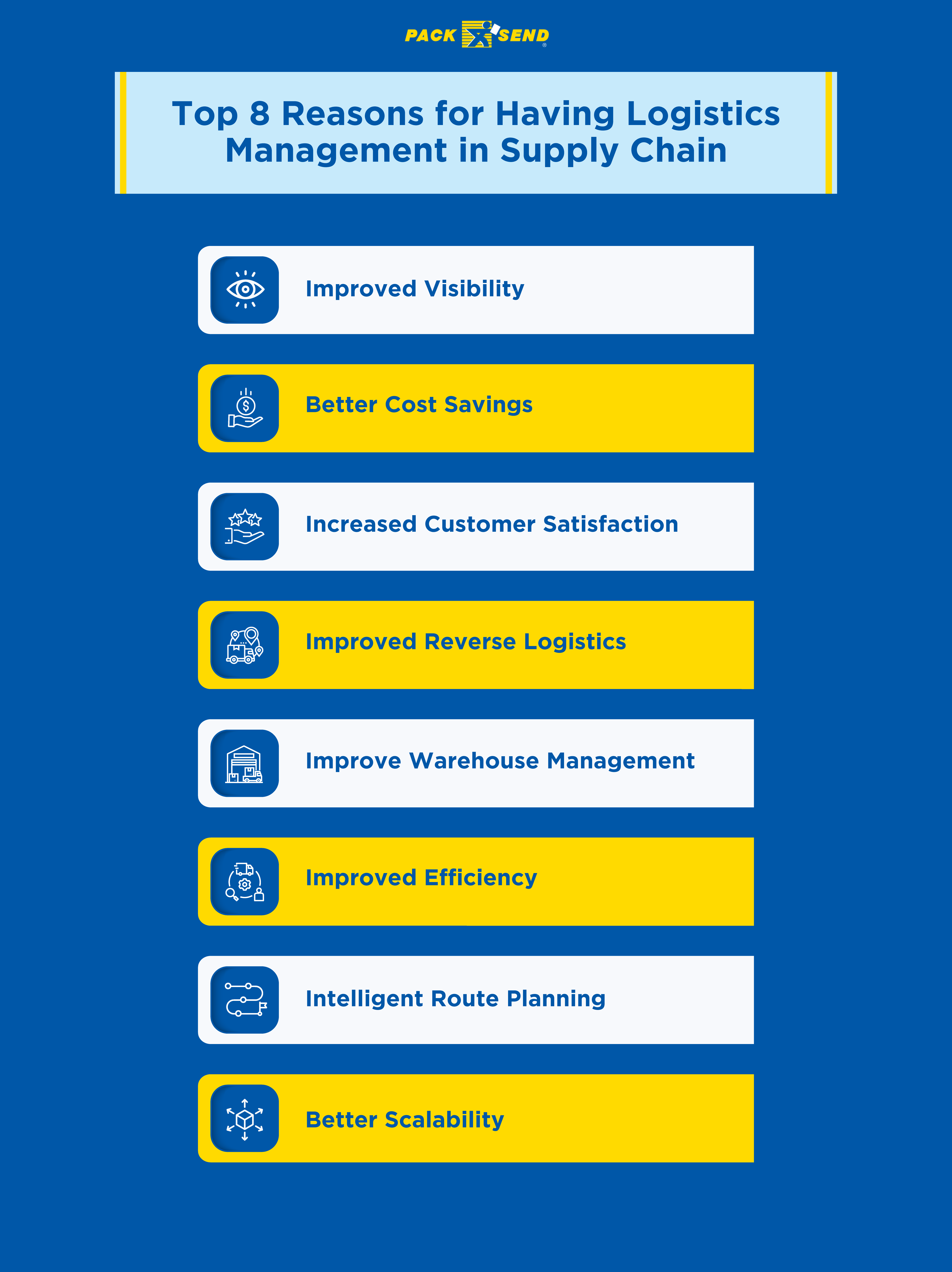
1. Improved Visibility
The success of integrated logistics management depends on the interconnectedness between departments. Real-time visibility increases productivity through data insights and streamlined communications. Effective logistics management brings different entities together to increase visibility across the supply chain.
Every party involved within the supply chain knows how much on-hand stock there is and when to place the next order. Everyone, including the customer, can track their orders and know when to expect the deliveries. With the latest technologies and advanced processes owing to automation, this real-time information paves the way for transparency and attracts new opportunities.
2. Better Cost Savings
Logistics is an expensive affair with the highest cost being that of transporting materials. But logistics management strategies help you analyse historical trends to understand the framework. You can predict future stock requirements, increase business productivity, and optimise operating costs.
Logistics management teaches you the art of lowering unnecessary expenses. You can gain better control of the profit margins. You leave less room for mistakes when you use automation and make the right use of data.
3. Increased Customer Satisfaction
Customers prefer being in the loop about where the order is and when they can expect the order to be delivered. Since logistics management improves visibility across the supply chain, the customer also benefits. It's because of the improved processes and early delivery time. You can add value to the customer experience by also optimising shipping costs and offering a seamless freight handling procedure.
As companies are also better equipped with data, they can assign customer queries to the support team to offer quick resolutions. It creates a lasting impression on the customer and increases a brand’s loyalty.
4. Improved Reverse Logistics
Almost all eCommerce businesses provide the option of product returns to make it convenient for customers to shop online. As a logistics company, it becomes imperative to have a returns management plan in case a customer places a return request. With a full-proof logistics management system, you can ensure efficient reverse logistics too.
Returns management also involves reclaiming materials and supplies from a production unit. Logistics management ensures there’s an enhanced distribution network. As the routes are already optimised by an order management system, you can use it to plan your return orders. It can reduce losses because of transportation and logistics.
5. Improved Warehouse Management
Warehouse management isn’t just about assessing the space and storage. It also requires evaluating the safety protocols within the facility to ensure a safe work environment. Logistics management practices help you conduct hygiene safety checks apart from monitoring and controlling operations in a warehouse.
The warehouse is the core pillar of the logistics industry. Effective logistics management ensures warehouse spaces are fully utilised. They also ensure warehouses and facilities are safe places to work and are equipped with technological systems.
6. Improved Efficiency
One of the primary goals of logistics management is to find bottlenecks in the supply chain process. You need to evaluate both inbound and outbound logistics operations. Hence, it helps you find inaccuracies and errors way before the product is even shipped. Logistics management practices like warehouse and inventory management notify businesses when to restock, check product quality, and optimise warehouse layout.
Logistics managers also improve efficiency by sourcing vendors who’re great with quality inspections to reduce shipping errors. It enhances communication with the supply chain and promotes interconnectivity between departments.
7. Intelligent Route Planning
To achieve efficiency in delivery, you need to fulfil two parameters — speed and low cost. It is nearly impossible to achieve this with all your deliveries if you plan your routes manually. Route planning is an integral part of logistics management. Optimising routes can not only prove to be a great cost-saver but also fulfil customer expectations.
Fleet managers can monitor the status of drivers and vehicles to ensure they’re following the safety rules and compliances. It can allow you to save on fuel costs and avoid untimely delays. With intelligent route planning software, you can improve last-mile logistics (final delivery) and fulfil speedy delivery demands.
8. Better Scalability
Logistics may seem easy when you have fewer orders and fewer customers. It's easy when you have a single warehouse that you use for inventory storage. But every business strives to grow. As your sales escalate, you need to organise activities across the supply chain to support scalability. Efficient logistics management helps you calculate inventory needs. It provides agile solutions designed to ensure scalability and responsiveness.
Your business can expand due to increased visibility, standardised warehouse procedures, and automation. It paves the way for strategic partnerships and a large customer base in the future.
Finishing Thoughts
Logistics management is an amalgamation of multiple factors that you need to consider to ensure the smooth functioning of your supply chain. The essence of modern logistics management lies in the level of technological adoption. It’s what helps businesses identify cost-saving measures by improving productivity.
Considering the bandwidth that today’s logistics covers, it's ideal to have a set of expertise. They can help you with key aspects of your logistics process. With PACK & SEND, you can ensure successful management that ensures speedy deliveries to your customers at a minimal cost. Whether you’re a small business, corporation, or online store start-up, you can contact us for a one-stop shop logistics solution. It is comprehensive and can be customised to support your operations.
Frequently Asked Questions (FAQs)
1. What is logistics management?
Logistics management is a process within the supply chain. It helps businesses in planning, managing, and implementing processes to move and store goods until the final sale. Logistics management encompasses inbound, outbound, and reverse logistics in the eCommerce supply chain.
2. What are the basics of logistics management?
Logistics management encompasses various activities within the supply chain. It includes concepts of supply chain management, order fulfilment, warehousing, and inventory management.
3. Why is logistics management important for the Supply Chain?
Logistics management is at the core of the supply chain. Every function of logistics management is dedicated to running a smooth supply chain. It ensures that customers receive their products on time. Moreover, it keeps the costs associated with inventories and storage as minimal as possible.
4. What are the benefits of logistics management?
Logistics management helps with many activities including:
- Inventory optimisation,
- Improving distribution network
- Demand forecasting
- Use of automation in warehouse and inventory management
